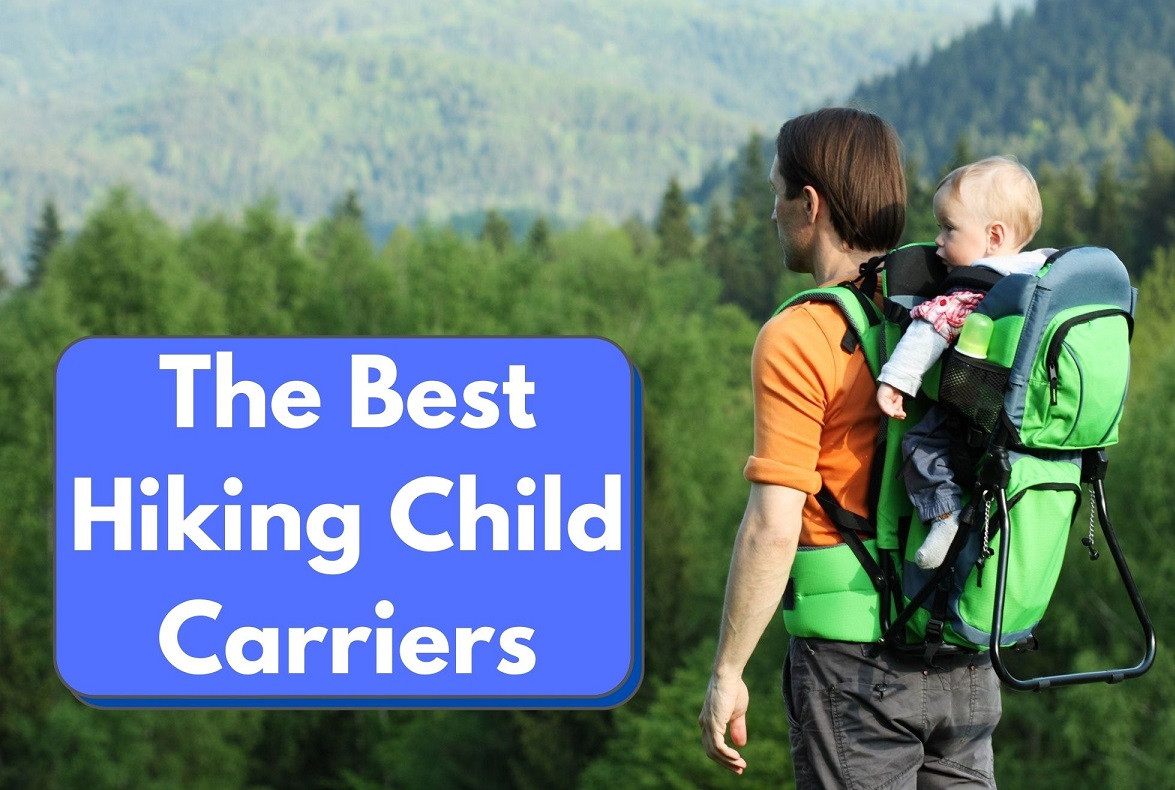If you’re planning on hitting the trail as a family and have babies or toddlers, you’ll definitely want the best hiking child carrier that you can find.
Child backpack hiking carriers offer safety and comfort for both you and your child, ensuring a better quality of hike for everyone involved.
The multitude of child hiking carrier choices available can often be a stumbling block for so many parents, which is exactly why we created this guide to the best baby and toddler carriers for hiking.
Read on for our top picks, what features to look for, and more when making your selection.
The Best Hiking Child Carriers – Quick Reference
| Best Overall Hiking Child Carrier | Deuter Kid Comfort Child Carrier |
| Best Hiking Child Carrier Runner-Up | Osprey Poco Plus Child Carrier |
| Best Mid Budget Hiking Child Carrier | Kelty Journey PerfectFIT Child Carrier |
| Best Low Price Hiking Child Carrier | ClevrPlus Cross Country Child Carrier |
| Best Mid Budget Hiking Child Carrier Runner-Up | LuvdBaby Premium Baby Backpack |
| Best High Storage Capacity Hiking Child Carrier | Phil & Teds Escape Child Carrier |
The Best Baby And Toddler Hiking Carriers
Deuter Kid Comfort Child Carrier

The Deuter Kid Comfort child carrier is the ultimate combination of safety, durability, storage, and comfort – all at a reasonable price.
Deuter packs are well-known for their excellent suspension systems, and this carrier features a robust metal frame that handles kids of different ages, sizes, and activity levels with ease.
The mesh back panel ensures comfort for you, and the baby seat design is one of the best we’ve seen.
There’s a five-point harness that’s easily adjustable, and the supportive materials throughout are also washable, enabling you to keep the carrier in great shape over many hikes to come.
Weight: 6 lbs. 6 oz.
Capacity: 26 liters
Max Weight (gear, child, and pack): 50 lbs.
Why We Like It:
-Lightweight
-Washable and comfortable materials for you and your child
-Included sunshade
-Excellent durability and suspension system
Osprey Poco Plus Child Carrier

Osprey has built a name for themselves as making great packs, and that rings true with the Osprey Poco Plus child carrier.
There are a few really nice features on the Poco Plus such as extra padding on the hip belt, and a harness that conveniently buckles behind your kiddo’s shoulder, which is great.
The back mesh panel makes sure you’re not sweating like crazy when on the hike, and the lightweight tubing frame provides heavy load carrying suspension while still maintaining a lightweight profile.
The Poco Plus also has a few additional creature comforts like a drool pad and quick adjustability in case you’re swapping carrying duties with another adult while on the trail.
Weight: 7 lbs. 14.4 oz.
Capacity: 26 liters
Max Weight (gear, child, and pack): 49 lbs. 8 oz.
Why We Like It:
-Easy adjustability
-Deluxe padded cockpit
-Lightweight frame with heavy-duty suspension
-Fits multiple torso sizes and adult heights
Kelty Journey PerfectFIT Child Carrier

If you’re looking for a feature-packed baby or toddler hiking carrier on a budget, our top pick is the Kelty Journey PerfectFIT carrier.
The cost savings comes with a tad less comfort, but this pack is no slouch: it’s well-padded and the seat can be easily adjusted to optimize your child’s sitting position.
Another big plus for the PerfectFIT is that it is nearly two pounds lighter than many of the other packs we reviewed in this guide.
There is a little less storage on this pack at only 17 liters, but you can easily supplement that with a separate daypack, and you’ll save plenty of money by using this carrier.
Weight: 6lbs. 6 oz.
Capacity: 17 liters
Max Weight (gear, child, and pack): 50 lbs.
Why We Like It:
-One of the most affordable child hiking packs we’ve reviewed
-Easily adjustable and fits many adult body sizes
-Lightweight
-Plenty of storage pockets
ClevrPlus Cross Country Child Carrier

If you’re on a tight budget, you won’t find a better pack than the ClevrPlus Cross Country child carrier.
At under $150, this carrier still manages to pack in plenty of features, like a kickstand, plenty of storage, a sunshade, and clear sides for visibility.
The straps are well-appointed and offer many adjustment options for both you and your child.
The padding leaves a little to be desired, so we recommend this pack for shorter hikes or the weekend-warrior types.
Weight: 7 lbs. 14.4 oz.
Capacity: Unknown
Max Weight (gear, child, and pack): 40 lbs.
Why We Like It:
-Extremely affordable
-Plenty of adjustable straps
-Lightweight at under 6bs total
-Built-in sunshade and rain cover
LuvdBaby Premium Baby Backpack

The LuvdBaby Premium Baby Backpack is an affordable hiking child carrier that offers plenty of features at an affordable price point.
This carrier includes a sunshade, plenty of pockets, and a kickstand for easy use and extra convenience.
This packs is great for multiple adults as well thanks to the adjustable shoulder and hip straps, which are also well-padded.
The hefty suspension also does a great job of distributing weight evenly, keeping the strain off your back, while the mesh back allows plenty of ventilation where it’s most needed.
Weight: 7 lbs. 14.4 oz.
Capacity: Unknown
Max Weight (gear, child, and pack): 40 lbs.
Why We Like It:
-Plenty of great features
-Affordable price point
-Solid suspension and easy adjustability
-Built-in diaper changing pad and sun shade
Phil & Teds Escape Child Carrier

Phil & Teds is a New Zealand-based baby product company who focuses exclusively on baby products, and the Escape Child Carrier is their premium hiking carrier for kids.
There are tons of great features in this pack like a sunshade, stirrups, and even a diaper changing pad.
The Escape also includes a removable, zip-off daypack and still manages to stay lightweight at under 7 lbs.
Weight: 6 lbs. 10 oz.
Capacity: 30 liters
Max Weight (gear, child, and pack): 39 lbs.
Why We Like It:
-Lightweight
-Lots of features
-Plenty of adjustability and a whopping 30 liters of storage
-Mid-range price point
Why You Should Use A Baby Backpack Or Toddler Carrier For Hiking
Using a child backpack carrier when hiking is going to ultimately be safer and easier for you to manage than a stroller, and allows you to cover additional terrain that a stroller simply can’t tackle.
Once you’ve got a great-fitting carrier, it will provide comfort and durability for many future hiking trips, and most can be easily shared between parents to lighten everyone’s load.
We should mention that there are some very capable hiking strollers out there, and you can check out our guide to the best all terrain hiking strollers for some great recommendations.
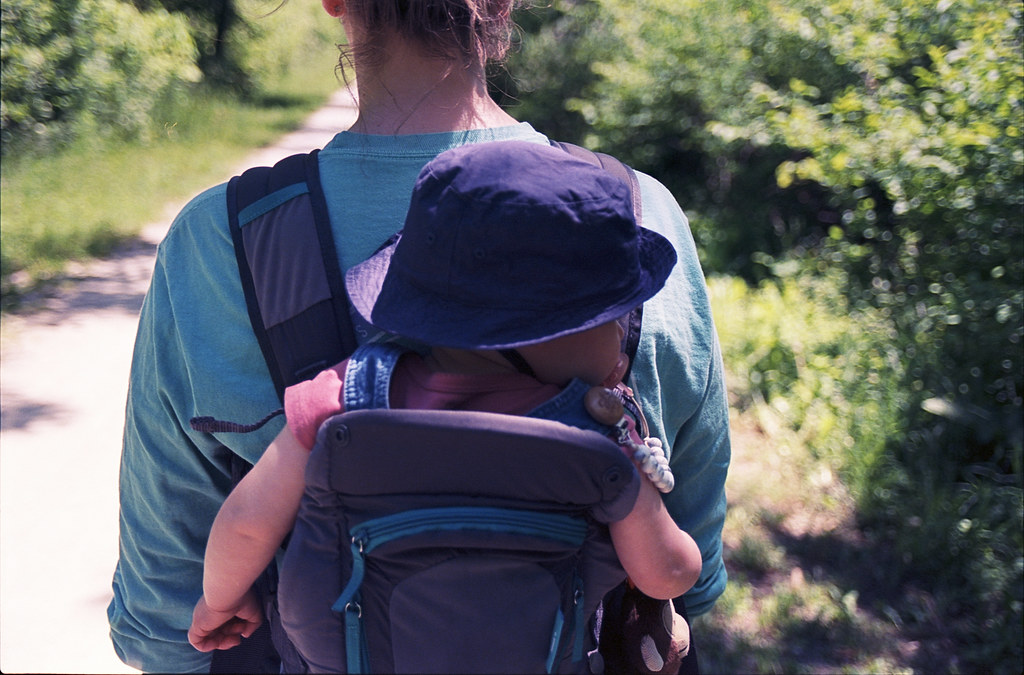
What To Look For In A Toddler Or Baby Hiking Carrier
There are so many options of child backpack carriers available that it can be overwhelming, especially with anything that has to do with your child’s safety and comfort in mind.
We’ll break down what exactly to look for in our guide below to help you in this process.
Types Of Baby And Toddler Carrier Packs
Comfort Packs
Comfort-focused child carriers pack lots of features and comfort options into their design, and typically resemble a backpack-style layout with an open cockpit for your child to sit in.
Comfort packs feature sturdy metal frames that provide great support for hauling kids up to 50 pounds, and have several pockets for carrying all kinds of supplies you’ll need while hiking.
These types of hiking child carriers are typically heavier and can take up a good bit of space even while folded, but are well worth it if you’ll be going on several hiking trips (or more) with your child each year.
Lightweight Packs
Lightweight child hiking carrier packs have less features and weight than comfort packs, and are great for shorter hikes.
The trade-off for a lighter pack that’s easier to store is that lightweight packs usually aren’t as comfortable to use and offer less storage.
If you plan on doing only a few short and simple hikes a year, lightweight packs will do fine, but otherwise we strongly recommend going for a comfort carrier.
Baby Carrier Comfort And Padding
Since you’ll be doing the carrying, the comfort and padding of your carrier is going to be of extreme importance!
You’ll want to look for padding in the hipbelt and shoulder straps that offers firm yet supple materials (memory-foam type firm materials are best).
Many of the best baby and toddler carriers for hiking that we reviewed feature strong suspensions, enabling you to carry children up to 50 pounds.
Child Carrier Harness Comfort And Adjustability
Your kiddo’s safety is a top priority, and as such, having a secure harness is a key feature of all the child backpack carriers we reviewed in this guide.
You’ll want to choose a pack that has soft touch fabrics and ample padding, as well as plenty of comfort, adjustability, and support around they key areas of your child’s movement like shoulders, arms, and legs.
Child Hiking Carrier Backpack Cockpit Comfort
When we talk about the “cockpit”, we’re referring to the area surrounding your child while they’re sitting in the pack.
A good carrier cockpit will have tall sides, a tall back, and a large and cushiony pad in the front, keeping kids supported and cozy if they fall asleep while in the carrier.
Sun And Rain Protection For Your Baby Or Toddler
Hiking exposes everyone to the elements, and sun exposure for babies and toddlers is a big concern.
Almost all hiking child carriers have some sort of built-in sunshade that also can be stored away when not in use.
If you’ll be hiking in rain (or the forecast is iffy), some of the best hiking child carriers we reviewed do offer separate rain covers as well.
Be sure to pick up a child carrier rain cover if you think precipitation is even a remote possibility on your hikes- you’ll thank us for it later.
Child Hiking Carrier Adjustability Options
If you’ll be trading child-hauling duties off with a partner, then be sure your selected carrier is easily and highly adjustable.
Make sure the torso measurements are good for you and your adult hiking partner, and check to make sure the padding on the belts and straps also provide ample cushioning for each of you where needed.
Storage Options And Available Pockets On The Hiking Child Carrier
Most of the best baby and toddler hiking carriers we reviewed in this guide offer many pockets for lots of organization and storage.
Most carriers include a front pocket, a larger zippered bottom pocket, and a few additional pockets along the top or sides.
Having supplies at the ready when hiking with babies or toddlers is key, and having enough storage for all those supplies is no exception.
Look for a pack that offers at least 15 liters of storage capacity when making your choice.
Ventilation And Breathability
There are two main areas of ventilation to pay attention to on any child hiking carrier: the child’s seat and the adult’s back panel.
All the packs we reviewed offer great ventilation for baby and keep your body heat off of them, but the adult back panel’s ventilation methods can vary by model.
Look for a back panel that offers full mesh construction in order to keep your back cool, dry, and comfortable while carrying your child as you hike.
Ease Of Use
Your overall experience using your hiking carrier depends a lot on how easy the pack is to use.
Make sure to read up on the instructions and do a few practice runs setting up and getting your child in the carrier before heading out on your hike together to avoid frustration for both you and your child.
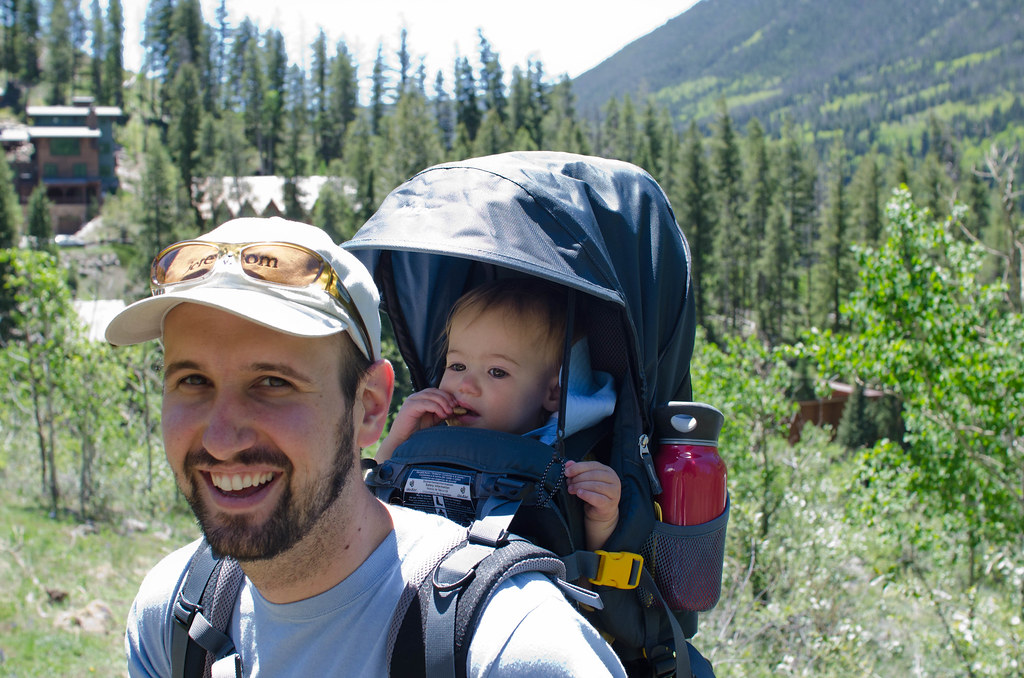
Features To Look For On The Best Toddler And Baby Hiking Carriers
Removable Daypacks
Some higher end hiking child carriers offer removable daypacks that zip off when they’re not needed.
This is a nice feature because you get more storage, while also having the ability to have someone else carry the removable daypack, thereby lightening your load.
Having said that, you can absolutely just go for a separate backpack or daypack and have the same functionality.
Water Storage
Just like many hiking packs, water storage is of high importance.
Several of the best toddler carriers for hiking we reviewed here offer a sleeve where you can slip in a water reservoir and drink tube to keep you and your little one hydrated on the trail.
If you’re not looking to use a reservoir, you can simply slip a water bottle in one of the side pockets found on many child carriers.
Stirrups or Foot Rests
A few carriers offer stirrups and footrests for your child to slip their feet in, helping them to maintain proper sitting posture while riding in the carrier seat.
These are nice on longer trips, as it keeps your child in better position, and helps to keep dangling feet from swinging out and kicking your arms or the pack while you’re hiking.
Some stirrups are removable as well, so you can store them until your child is the appropriate age for their use.
Suspension
Nearly all the child hiking packs we reviewed feature a suspension system, but some also offer adjustable suspension system as well.
This adjustable suspension is great when multiple adults will be using the carrier for comfort and functionality purposes.
Extra Features
Some baby hiking carriers will also offer extra features like drool pads or mirrors, which are extra creature comforts.
Consider the benefits of these features and if paying extra is worth it to you to have them on your pack.
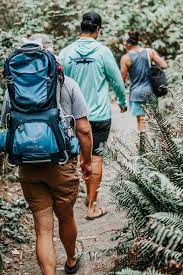
Other Items To Pay Attention To When Selecting Your Hiking Child Carrier
Child Carrier Age And Weight Limits
Most child carriers are made for children between 16 and 50 pounds, with the lower end being the weight where most children can support their head independently while in the carrier.
Depending on your child’s existing weight and age, consider the total range that your carrier supports before choosing one to make sure you get a good amount of use from it.
And please: be absolutely certain that your baby can support his or her head before taking them on a hike in a carrier pack.
JPMA Certification
Some packs will be JPMA Certified, meaning that they’ve gone through an independent, 3rd-party testing process that makes sure the child carrier follower state, federal, and ASTM restrictions.
This is an added feature that doesn’t necessarily mean it’s safer, but at least the additional stringent testing makes sure your chosen hiking carrier passes extra tests with flying colors.
How Should A Child Hiking Carrier Fit?
Selecting a baby or toddler hiking carrier that syncs up with your torso length is critical to your comfort when you hit the trail.
As a rule of thumb, the more customizable or adjustable options (like hip belts, straps, and suspension adjustments) the better.
This goes double if you plan on having multiple adults using the carrier.
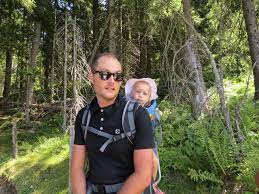
Tips For Hiking With Babies And Toddlers
Now that you’ve got a good way to transport your child, there’s still plenty of other things to consider.
Preparation is key when it comes to hiking with babies and toddlers – check out our guide to hiking with toddlers and babies to know exactly what to plan for and what to bring with you on your next outing.
Child Backpack Carrier FAQs
You can bring your baby hiking in a carrier typically around 6 months of age.
Your baby is ready for a backpack carrier when they can hold their head up on their own, sit up on their own, and when they meet the minimum height and weight suggestions for your selected carrier.
A baby or toddler hiking carrier is not required, but it will make your hikes much more enjoyable.
If you are planning on only going for a few short, simple hikes each year, you can opt for a soft pack that can be worn front or back.
However, if you plan on hiking or backpacking often or on longer trips and different terrains, we highly recommend a proper carrier.
Just like any outing with little ones, layering clothing is key.
Depending on how cool the weather is, you may consider a lightweight warm top and layering fleece on it.
Don’t forget to bring a hat!
Outward-facing child carriers are not recommended for children of any age.
Being prepared on the trail is very important, so make sure to consider everything you’ll need.
Check out our guides to hiking with toddlers or our breakdown of kids hiking gear for some great recommendations and packing lists.

